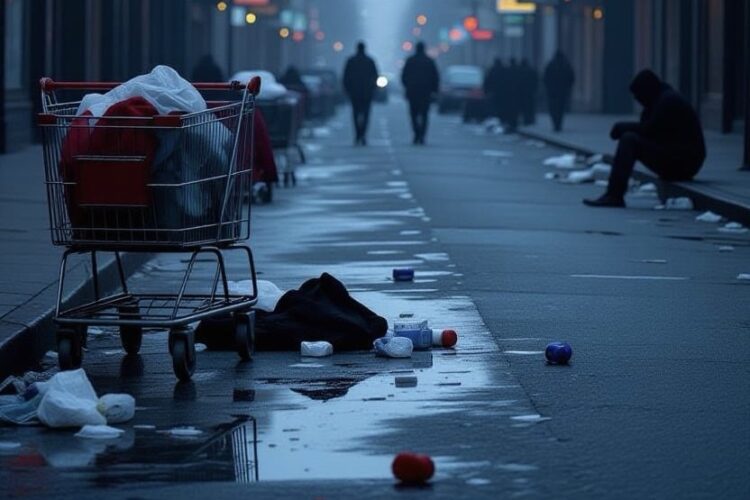Downtown San Francisco faces a drug zombie apocalypse, with fentanyl-laced drugs fueling a crisis of addiction, homelessness, and urban decay. The Tenderloin and Union Square are hotspots, where open-air drug markets and encampments thrive, driving crime and overdose deaths—806 in 2023, 635 in 2024, and rising in 2025. Fentanyl, often mixed with meth or heroin, causes zombie-like states and accidental overdoses. Harm reduction, like Narcan distribution and safe injection sites, competes with calls for crackdowns, mandatory treatment, and dealer prosecutions. Housing First policies draw criticism for enabling addiction, while drug tourism worsens the issue. Despite a 2025 fentanyl emergency declaration, the city struggles with a mental health crisis and lawless streets. Recovery-focused housing, behavioral health support, and supply chain interventions offer hope, but bold action is needed to end this doom loop and restore downtown.
Long Version
The Drug Zombie Apocalypse in Downtown San Francisco: Unraveling the Fentanyl Epidemic and Urban Decay
Downtown San Francisco, once a vibrant hub of innovation and culture, has devolved into what many describe as a drug zombie apocalypse—a post-apocalyptic dystopia where zombie-like figures, drug-addled and hunched over in fentanyl-laced stupors, wander streets littered with drug paraphernalia. This street horror unfolds amid rampant public drug use, encampments sprawling across sidewalks, and a crime wave that has turned neighborhoods into open-air drug markets. The doom loop of addiction, homelessness, and behavioral health breakdowns has gripped areas like the Tenderloin neighborhood and Union Square, painting a grim picture of urban decay and human rights violations in one of America’s wealthiest cities. As of October 2025, this public health emergency continues to claim lives, with opioid-linked deaths fueling debates on policy failures and potential solutions.
The Roots and Scale of the Drug Crisis
The fentanyl epidemic in San Francisco traces back to the mid-2010s, when synthetic opioids like fentanyl began infiltrating the drug supply, often laced into methamphetamine (meth) or black tar heroin. This potent mix has escalated accidental overdoses, turning routine drug use into lethal encounters. By 2023, the city recorded a staggering 806 overdose deaths, the highest on record, with fentanyl involved in over 70% of cases. While numbers dipped to 635 in 2024 amid national trends showing a 30,000 annual drop in U.S. fentanyl deaths, provisional data for 2025 indicates a resurgence, with 53 deaths in August alone, 42 linked to fentanyl. From 2019 to 2025, over 4,000 lives have been lost to this crisis, transforming San Francisco into a battlefield of chemical warfare orchestrated by drug trafficking networks, primarily from Honduras and Mexico.
Homelessness exacerbates the issue, with about 65% of unhoused individuals reporting regular illicit drug use at some point in their lives. Encampments in downtown areas serve as hubs for public drug use, where users openly inject or smoke, contributing to a mental health crisis intertwined with addiction. Behavioral health experts note that many suffer from co-occurring disorders, yet the city’s permissive environment has enabled drug tourism, drawing out-of-towners to exploit cheap, potent supplies. Nearly half of drug users in San Francisco are visitors, fueling debates on whether aid should prioritize locals or perpetuate this influx.
Hotspots of Despair: Tenderloin and Union Square
The Tenderloin neighborhood stands as ground zero for this dystopia, where open-air drug markets thrive blocks from tourist attractions. Here, fentanyl-laced substances are sold brazenly, with dealers weighing portions in broad daylight near BART stations. Over 40% of the city’s overdose deaths occur in Tenderloin and SoMa, often on sidewalks or in single-room occupancy hotels. Residents describe scenes of zombie-like addicts lurching through streets, stabbing passersby amid unpunished crime. In February 2025, a multi-agency raid on Jefferson Square Park—dubbed “Zombie Park”—led to dozens of arrests, highlighting how drug clusters migrate, disrupting nearby areas.
Union Square, once a bustling shopping district, now borders this chaos. Drug-addled individuals smoke fentanyl openly, deterring shoppers and leading to store closures, like the two-story Walgreens flagship in January 2025. Families and tourists encounter herds of addicts shepherded by police sirens in ritualistic migrations toward SoMa or Chinatown, underscoring the failure to contain the spread. This proximity to open drug markets has stalled downtown recovery, with boarded-up windows and pervasive human waste evoking a zombie apocalypse narrative that harms the city’s reputation.
Substances Driving the Epidemic
Fentanyl, a synthetic opioid 50 times stronger than heroin, dominates the scene, often fentanyl-laced into meth or black tar heroin for a longer high. This contamination has spiked fentanyl overdoses, with users collapsing in zombie-like states multiple times daily. Methamphetamine adds to the volatility, fueling aggressive behaviors in encampments. Emerging threats like “tranq” (xylazine mixed with fentanyl) compound risks, creating wounds and prolonging highs in Los Angeles’ similar crisis, which mirrors San Francisco’s. Drug trafficking sustains this, with SFPD seizing over 90 kilos of fentanyl in one year, yet dealers operate with impunity.
Human Toll and Societal Impacts
The crisis manifests in opioid-linked deaths and a broader mental health crisis, where drug-addled individuals roam like zombies, blocking sidewalks and spilling into streets. Accidental overdoses in supportive housing highlight policy flaws—hundreds have died in these units, where recovering addicts struggle amid neighbors using dope. The crime wave includes theft and violence, with small businesses shuttering and “For Lease” signs proliferating. This urban decay represents a human rights violation, as vulnerable populations endure lawless encampments without adequate intervention.
Policy Responses: Harm Reduction vs. Crackdowns
San Francisco has invested tens of millions in harm reduction strategies, distributing over 500,000 Narcan (naloxone) doses for overdose reversal. Safe injection sites, though controversial, aim to prevent fatalities, while street teams provide outreach. The Housing First model offers shelter without sobriety requirements, but critics argue it enables addiction, with state officials obstructing drug-free options. Some blame a “woke mind virus” for permissive policies that reward chaos, calling for mandatory treatment, dealer prosecutions, and National Guard deployment. In 2025, Mayor Daniel Lurie advanced a fentanyl state of emergency, aiming to curb open-air markets and encampments. Yet, vigilante actions—like spraying Narcan on sleeping homeless—blur lines between help and harm, risking medical complications.
Insights and Path Forward
This crisis isn’t inevitable; national fentanyl death declines suggest supply disruptions and awareness campaigns work. San Francisco’s 21% overdose drop from 2023 to 2024 shows progress, but creeping 2025 numbers demand sustained action. Valuable insights include prioritizing recovery-inclusive housing over unchecked Housing First, enhancing behavioral health integration, and targeting drug tourism through border controls. Community voices, from recovery advocates to residents, emphasize that compassion requires accountability—ending the revolving door of arrests and fostering a fentanyl-free environment. Without bold shifts, the zombie apocalypse risks becoming permanent, but coordinated efforts could reclaim downtown from this grip of despair.
Hashtags For Social Media
#SanFranciscoCrisis #FentanylEpidemic #DrugZombieApocalypse #UrbanDecaySF #TenderloinTrouble #HomelessnessCrisis #OpioidOverdose #ZombieApocalypseSF #SFDowntownDecay #CrimeWaveSF #PublicDrugUse #HarmReduction #NarcanSaveLives #MethAddiction #BlackTarHeroin #DrugTourism #MentalHealthSF #HousingFirstFail #SafeInjectionSites #WokeMindVirus #DoomLoopSF #StreetHorror #OpenAirDrugMarket #BehavioralHealth #OverdoseDeaths #HumanRightsSF #PostApocalypticCity #DystopianSF #ReclaimSanFrancisco #FentanylFree
Related Questions, Words, Phrases
what is the san francisco drug crisis | why is downtown san francisco called a zombie apocalypse | how bad is the fentanyl epidemic in san francisco | what causes urban decay in san francisco | san francisco tenderloin drug problems | why are there so many homeless in san francisco | how does fentanyl affect san francisco streets | what is the open-air drug market in san francisco | san francisco overdose death statistics | how to fix san francisco drug crisis | what is harm reduction in san francisco | why is union square san francisco unsafe | fentanyl overdose rates in tenderloin | san francisco drug trafficking issues | what are zombie-like addicts in san francisco | how does homelessness worsen san francisco drug crisis | san francisco public drug use problem | what is the doom loop in san francisco | why do people call san francisco dystopian | san francisco mental health crisis explained | how effective is narcan in san francisco | san francisco housing first policy issues | what is the woke mind virus in san francisco | san francisco safe injection site debate | why are there encampments in san francisco | san francisco crime wave causes | how does drug tourism affect san francisco | what drugs are driving san francisco crisis | san francisco fentanyl emergency 2025 | how to stop san francisco urban decay | why are businesses closing in san francisco | san francisco behavioral health challenges | what is tranq drug in san francisco | how does meth contribute to san francisco crisis | why is san francisco downtown struggling






